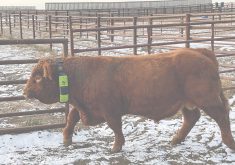Several Alberta beef producers are paying attention this summer and winter to determine how a popular New Zealand crop, known as forage brassica, fits in with a range of grazing options here in Western Canada.
This is all a spinoff from a 10-acre trial last winter, using the forage brassica (also known as rape or kale) that was swathed and used for winter grazing by Graeme Finn of Crossfield, just north of Calgary. The forage brassica is actually a cross between turnip and kale. Although it varies with field conditions, it produces big broad leaves and grows from one to two feet in height.
Read Also

Claas brings 1000 Series SP forage harvesters to Canada
In mid-August, Claas unveiled its new line of Jaguar forage harvesters at an event in Visalia, California, deep in the heart of that state’s dairy region.
Finn has been winter swathing grazing, usually dry cows, for many years, on a combination of oats and barley swaths. Last year, under the auspices of the Foothill Forage and Grazing Association, he tried about 10 acres of the forage brassica. After a positive experience with that, this year he seeded about 150 acres in a blend with oats and barley. He’ll start grazing that in late October or early November.
“It made an excellent forage for swath grazing last year,” says Finn. “The 10-acre plot was part of a larger 130 acres of oats and barley swaths, and the cows just camped on that 10 acres like it was ice cream. They cleaned it up before moving into the oats and barley swaths.”
The forage brassica has up to 19 per cent protein compared to oats and barley, which have about nine to 10 per cent protein in the swath. Finn, who farms along with his father-in-law Don Evans, will run about 210 head of dry cows on the 150 acres of swaths. It should last the herd right through until May.
- From the Canadian Cattlemen: Can Canada thistle be a remedy for overgrazing?
“We’re hoping by including the forage brassica in the winter grazing that cows will do a better job of cleaning up the swaths,” says Finn. “Other years there is quite a bit of trash left behind and we’ve had to heavy harrow the field in the spring. We’re hoping by including this very palatable forage in the swath they’ll do a better job of cleanup.”
Pasture alternative
At another farm, north of Calgary, Wynn Chisholm of WA Ranches is redeveloping some old timothy hay fields. As those were renewed last summer, cow-calf pairs grazed about 150 acres of annual pasture made up of the similar forage brassica, oats and barley blend.
That seeding was divided into 50-acre blocks, with the herd making at least two passes through each paddock. In central Alberta, one producer has included the forage brassica in an annual pasture blend for sheep, and there are also some trials using forage brassica near Lethbridge.

And east of Calgary, near Irricana rancher Doug Wray has seeded an 80-acre trial of the forage brassica (kale) barley and oats to be used for swath grazing this winter.
He’s hoping the higher-protein brassica will improve the weight gain on backgrounded calves. “Even if it is only one-quarter pound more per day that is about 30 to 40 pounds more over the winter,” says Wray.
Wray has been winter swath grazing cattle for about 20 years. He runs a 300 head cow-calf herd, and weans calves in mid-November. He backgrounds those calves over winter with plans to sell them the following September.
After weaning, the calves will move into stockpiled forage on the farm and eventually — depending on the year — move into the swathed annual crop in late December or early January. “Usually we grow a blend of oats and barley for the swath grazing,” says Wray. “We have tried winter triticale in the past. It had quality, but didn’t produce the tonnage we had hoped. This year the forage brassica looks good, but we’ll see how it does.”
Wray seeded 80 acres of the forage brassica, barley and oats blend. He seeded the brassica at a rate of two pounds per acre along with 3/4 of a bushel of barley and one bushel of oats. The cereals were seeded with a drill, while the brassica was applied with a Valmar broadcast seeder and then harrowed. The mixture was seeding June 15 and was to be swathed by early September.
Most years, with average snow cover, the calves have no trouble finding the feed, says Wray. He is prepared to supplement with hay if adverse weather makes for particularly tough winter grazing conditions. Last year with heavy snow that eventually crusted he did devise a disc-style tool that he could pull over the swaths to move snow and give cattle access to the feed. “We will feed hay if we need to, but ideally the plan is to put calves on the swaths in January, limit feed so we are moving an electric wire every day, and hopefully the swaths will carry them through until spring.”
















